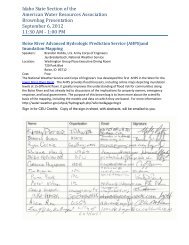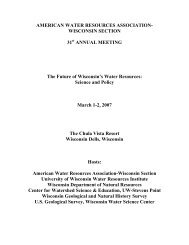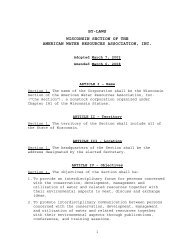Wisconsin's Role in Great Lakes Restoration - American Water ...
Wisconsin's Role in Great Lakes Restoration - American Water ...
Wisconsin's Role in Great Lakes Restoration - American Water ...
You also want an ePaper? Increase the reach of your titles
YUMPU automatically turns print PDFs into web optimized ePapers that Google loves.
3. Removal of Methylene Blue from <strong>Water</strong> by Swell<strong>in</strong>g Clays<br />
*Sam Leick, Geosciences Department, University of Wiscons<strong>in</strong> – Parkside, Kenosha, WI<br />
leick001@uwp.edu<br />
Zhaohui Li, Geosciences Department, University of Wiscons<strong>in</strong> – Parkside, Kenosha, WI<br />
li@uwp.edu<br />
Extensive but separate studies have been conducted to focus on utilization of swell<strong>in</strong>g clays<br />
to removal cationic dyes from aqueous solution and to <strong>in</strong>vestigate the feasibility and<br />
applicability of methylene blue (MB) adsorption for cation exchange capacity (CEC) and<br />
specific surface area (SSA) determ<strong>in</strong>ation. This research aimed at elucidat<strong>in</strong>g the mechanism<br />
of MB adsorption on low charge montmorillonite <strong>in</strong> order to better understand the pr<strong>in</strong>ciples<br />
beh<strong>in</strong>d MB removal us<strong>in</strong>g swell<strong>in</strong>g clays and to validate the practices of us<strong>in</strong>g MB for CEC<br />
and SSA determ<strong>in</strong>ation. Stoichiometric desorption of exchangeable cations from the clays<br />
accompany<strong>in</strong>g MB adsorption as well as the close match between the MB adsorption capacity<br />
and the CEC of the clays confirmed cation exchange as the most important mechanism for<br />
MB removal. XRD and TG-DTG analyses revealed <strong>in</strong>terlayer adsorption, thus, <strong>in</strong>tercalation of<br />
MB molecules. FTIR analyses suggested that hydrogen bond<strong>in</strong>g may not play a major role <strong>in</strong><br />
MB adsorption. The results confirmed that the charge density, rather than the SSA was the<br />
limit<strong>in</strong>g factor for MB adsorption. For the treatment of wastewater conta<strong>in</strong><strong>in</strong>g cationic dyes,<br />
swell<strong>in</strong>g clays with a high CEC value would result <strong>in</strong> a greater removal of MB.<br />
*Undergraduate student presentation<br />
29

















